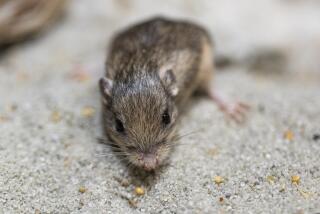OF MICE AND 120-YEAR-OLD MEN
- Share via
NR-1-243. Born Nov. 5, 1978. She is, or was, the oldest mouse in history. She was raised in the UCLA laboratory of Dr. Roy Walford, a man who, at age 62, believes that his life is only half over. Walford is a pioneer of “undernutrition.” He has enjoyed repeated, well-documented success keeping mice alive for extraordinary lengths of time, literally doubling their life spans by simply modifying their diets. And he makes few bones about what he believes this could mean in human terms. “If you took 100 people and put them on this kind of diet, some of them--not all--would live to be 135 to 145 years old.” That’s to say, some 25 years longer than the oldest living man in recorded history.
A fit, thin, soft-spoken man who, with his shaved head and drooping mustache, resembles a studious buccaneer, Walford practices what he preaches. For nearly three years, he’s been on a restricted diet, consuming a maximum of 2,000 calories a day and adhering to a regular program of exercise and weight training. A lifetime dedication to a similar program, he believes, would yield average life spans in the 100- to 110-year range.
To charges that his theories have yet to be demonstrated in an animal more complicated than a mouse, Walford responds: “That is simply not true. Recent studies of Okinawans on similarly restricted diets show that they have, for instance, 60% lower heart-disease and cancer rates than corresponding Japanese on neighboring islands.”
NR-1-243 is no longer with us, but her demise at age 55 months eclipsed the longevity record for mice of her species by 11 months. (David E. Harrison at the Jackson Laboratory in Bar Harbor, Me., has succeeded recently in coaxing a similar mouse to 59 months, according to Walford.) Perhaps more significantly, several of NR-1-243’s brothers and sisters lived substantially past the old 44-month high-water mark as well. “With these animals,” Walford says, “we’ve been able not only to increase the life expectancy of a species but the maximum life span as well. You can cure all the diseases you want, but that alone will not increase life span. You still hit the wall at about 110.”
Walford believes that decreased caloric intake helps to extend life several ways, among them: “It upgrades the level of the body’s free-radical scavengers and increases the DNA repair rate, rejuvenating the immune system.” There are other effects as well: “Animals on restricted calorie diets have puberty later and are fertile much longer, but have fewer children.”
Walford, whose recently published book, “The 120-Year Diet” (Simon & Schuster, 1987), is enjoying brisk sales, says reasonable diet restriction “takes about as much effort as becoming a vegetarian.” Like most scientists involved in research into aging, he believes the fundamental answers may be genetic. He thinks there are anywhere from a dozen to 70 genes or collections of genes that regulate enzymes responsible for DNA repair--specifically, a group called the “major histo-compatibility complex.” Similarly, he feels that life span is an arbitrary condition of human evolution eminently susceptible to tinkering. “There are a lot of vested interests in death; that’s what most religion is based on. If you don’t die, you don’t go to your reward. Many people are inherently resistant to the idea that life span is not an absolute. But I would not be surprised if, between the years 1990 and 2000, advances in the understanding of DNA repair led to life spans of 130 years or more.”




